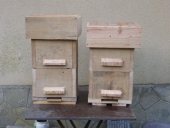Hi David,
I choose which queens I like the best, production, propolis but most of all temperment. Calm ,hardworking and clean. Some queens are just not nice, not calm on the comb or lazy. From the groups I admire, I use a feather to procure the most recently laid eggs I can find and place them on a rail fitted with queens cups, each rail has two rows of six, one below the other. This rail goes back to a large strong group for development and on the 17th day I detach each queen cup from the rail and place in a tiny nuc with a supply of fondant and literally a "cup" of bees. This nuc I close up for five days and allow the queen to emerge under the care of the cupful. I line up all these tiny nucs in the apiary and keep an eye on them and it is not difficult to tell over the next two weeks which are nice or mean, lazy or hardworking. I let mating take place naturally within the gene pool of the apiary. I then take the nicest of them and transfer to normal size nucs and continue to let them develop threw out the summer to a size that can make it threw the winter. Sometimes I combine these nucs by eliminating a queen. Sometimes I use them to replace older queens in the apiary. All in all I normally narrow down to the best four or five for the next season as I like to keep my apiary in the 10 to 15 hive region.
In regard to swarming...... I always make sure there is plenty of room in the brood box in the spring. And queens that have that tendency are always high on the list of those to be replaced. Also I put bait boxes around the property, for a lure I simply use a piece of brood frame that a queen has walked on in an old nuc box. This works very well and have noticed over the years that the bait boxes that work best are the ones that are placed on higher ground than the original hive and within the working radius of the apiary. If sometimes the group is totally determined to fly, I let it rather than chase it and try to force it to my will. And most years I have no swarming but collect swarms from the bait boxes that have been attracted from the wild or wherever.
By making queens each season I have more than enough and with the good atmosphere of the apiary the vast majority are happy and willing to stay. Also I do not inspect just for the sake, I have a lot of fruit trees and harvest the spring honey separate from the summer in the form of cut comb, so when I am doing this I just have a peek and this gives me a really clear view as to who is happy and content and who is not. All in all I try to leave them be, as the one thing I know for sure is that they know best.
In regard to varroa I use screen floors which give the group the oppertunity to help themselves and some groups are much better at this than others, the ones that are not are I often replace the queen and this always helps and if not simply put them down before a long slow winters death, but this does not occur to often. I also use 1 frame in the brood box that is from a super in the middle of the brood. This creates a gap that the bees do not like so they fill it with wild comb. For some reason the group likes to utilize this wild piece of comb for drone production and as the drones take longer to emerge than the rest, the varroa prefer to incubate in these cells. It makes it very easy for me to simply cut out this section and feed it to the birds and the varroa numbers stay very low.






